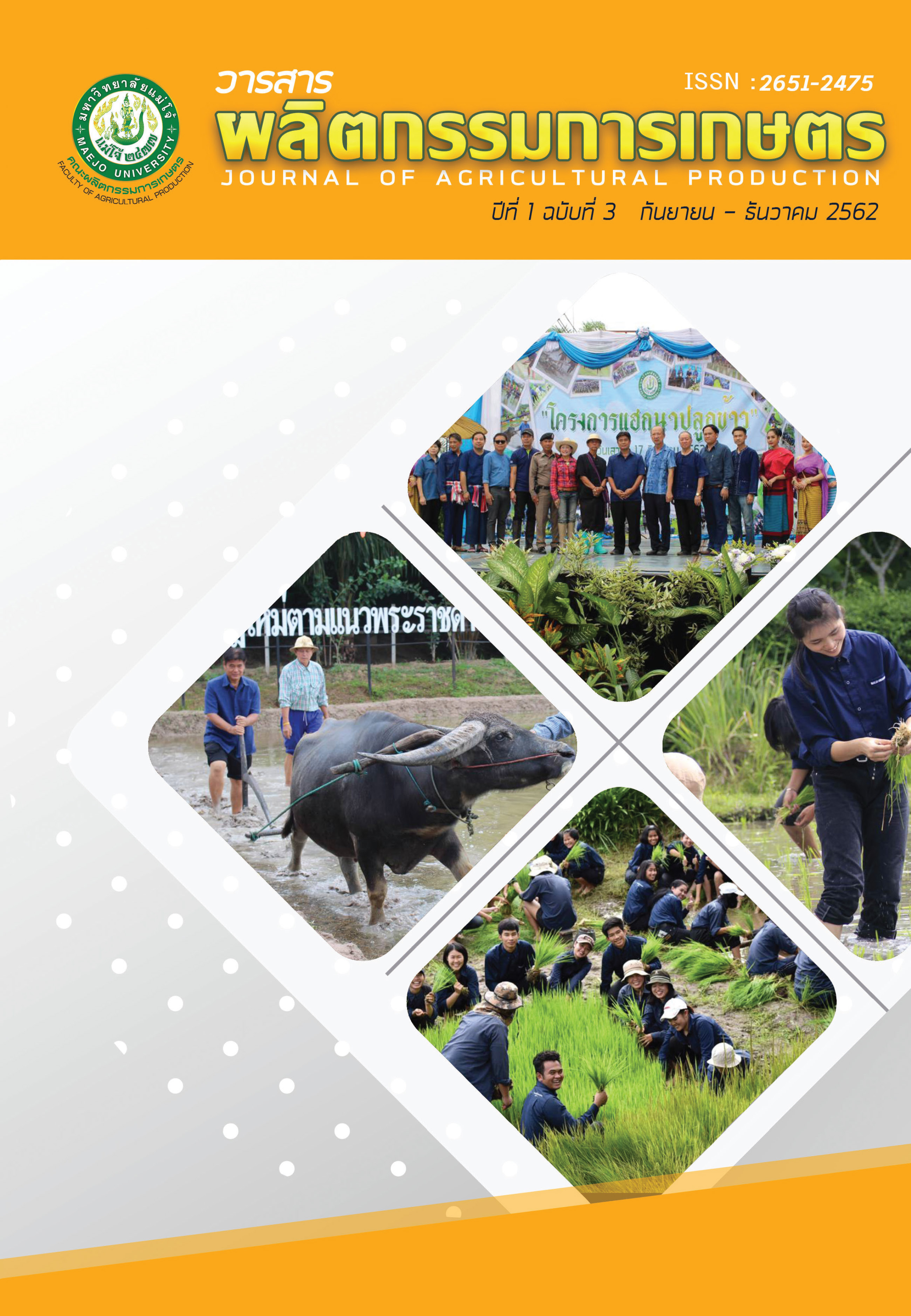ประสิทธิภาพของสารสกัดจากใบเขยตายในการควบคุม ลูกนํ้ายุงลายบ้าน
Main Article Content
บทคัดย่อ
แม้การใช้สารเคมีสังเคราะห์ในการควบคุมยุงพาหะนำโรคจะมีประสิทธิภาพดีในระยะเวลาสั้น แต่ ในขณะเดียวกันกลับส่งผลกระทบต่อความต้านทานของสารเคมีกับแมลงในระยะยาว รวมถึงการตกค้าง ของสารเคมีในสิ่งแวดล้อม การใช้สารสกัดจากพืชสมุนไพรเพื่อกำจัดยุงพาหะจึงเป็นทางเลือกหนึ่งที่สามารถ ช่วยลดบทบาทของการใช้สารเคมีสังเคราะห์ลงได้ การวิจัยครั้งนี้จึงมีวัตถุประสงค์เพื่อทดสอบฤทธิ์ของ สารสกัดจากใบเขยตาย Glycosmis pentaphylla โดยวิธีการสกัดด้วยเฮกเซนและแอลกอฮอล์ 95% ต่อยุงลายบ้าน Aedes aegypti ใน วัย 3-4 ด้วยวิธีหยดสารละลายที่ระดับความเข้มข้นต่างกัน (0, 1,250, 2,500, 5,000 และ 10,000 มิลลิกรัม/ลิตร) ภายหลังการทดสอบ พบว่า สารสกัดจากใบเขยตายที่สกัด ด้วยเฮกเซน มีค่า LC50 ต่อลูกนํ้ายุงลายบ้าน ที่ 24, 36, 48 และ 72 ชั่วโมง เท่ากับ 3,242.13, 1,920.62, 1,329.07 และ 1,251.32 มิลลิกรัม/ลิตร ตามลำดับ ขณะที่ สารสกัดจากใบเขยตายที่สกัดด้วยแอลกอฮอล์ 95% มีค่า LC50 ต่อลูกนํ้ายุงลายบ้าน ที่ 24, 36, 48 และ 72 ชั่วโมง เท่ากับ 2,493.59, 1,204.88, 1,534.69 และ 1,099.50 มิลลิกรัม/ลิตร ตามลำดับ อัตราการตายของสารสกัดจากใบเขยตายที่สกัดด้วยตัวทำละลาย ทั้งสองชนิดมีประสิทธิภาพสูง โดยที่ความเข้มข้นที่ 10,000 มิลลิกรัม/ลิตร มีผลทำให้ลูกนํ้ายุงลายบ้าน ตาย 100% ภายหลังการทดสอบที่ 24 ชั่วโมง ทั้งนี้ไม่พบอัตราการตายในชุดควบคุม พบว่าระยะเวลาที่ลูกนํ้ายุงลายบ้านสัมผัสสารสกัดที่ได้จากตัวทำละลายทั้งสองชนิดนานขึ้นอัตราการตายก็เพิ่มขึ้นตาม ไปด้วย นอกจากนี้ยังพบว่าสารสกัดที่สกัดด้วยตัวทำละลายทั้งสองชนิดให้ผลการตายของลูกนํ้ายุงลาย ที่ไม่แตกต่างกันในทุกๆ ชั่วโมงของการทดสอบ (P ≥ 0.05) จากผลการวิจัยในครั้งนี้ สารสกัดจากใบเขยตาย มีแนวโน้มที่จะนำไปประยุกต์ใช้ในการป้องกันกำจัดลูกนํ้ายุงลายบ้านและสัตว์ขาข้ออื่นๆ ที่เป็นปัญหาทาง สาธารณสุขในสภาพพื้นที่ต่อไปได้
Article Details

อนุญาตภายใต้เงื่อนไข Creative Commons Attribution-NonCommercial-NoDerivatives 4.0 International License.
เอกสารอ้างอิง
นิดา นันทกรปรีดา สมฤทัย ในแสน กีรติ ตันเรือน พิสิษฐ์ พูลประเสริฐ มนตรา ศรีษะแย้ม ดุษิต โพธิ์ทอง และ ยุวดี ตรงต่อกิต. 2560. ฤทธิ์ฆ่าลูกนํ้ายุงลายบ้าน (Aedes aegypti) ของสารสกัดเมล็ดน้อยหน่า (Annona squamosa) ที่หมักด้วยนํ้าส้มควันไม้. PSRU Journal of Science and Technology. 2(3): 33-40.
พิสิษฐ์ พูลประเสริฐ และเฉลิมพร ทองพูน. 2558. ประสิทธิภาพของสารสกัดจากดอกพญาสัตบรรณที่มีต่อลูกนํ้ายุงลายบ้าน. สักทอง: วารสารวิทยาศาสตร์และเทคโนโลยี (สทวท.). ปีที่ 2 ฉบับที่ 2 (กรกฎาคม-ธันวาคม) น. 23-29.
Abbott, W.S. 1925. A Method of Computing the Effectiveness of an Insecticide. Journal of Economic Entomology. 18: 265-267.
Ansari, P., A. Ulla, A.R.U. Islam, M. Sultana, M.N. Alam, M. Mustakim and M.N. Uddin. 2015. Ex-vivo cytotoxic, antibacterial and DPPH free radical scavenging assay with 171 ethanolic leaf extract of Glycosmis pentaphylla to justify its traditional use. Biomedical Research and Therapy. 2(7): 324-332.
Bulbul, I. and N. Jahan. 2016. Study on antioxidant and antimicrobial activities of methanolic leaf extract of Glycosmis pentaphylla against various microbial strains. Journal of Pharmacognosy and Phytochemistry. 5(4): 53-57.
Finney. D.J. 1971. Probit analysis. Cambridge Univ. Press, Cambridge.
Ghosh, A., N. Chowdhury and G. Chandra. 2012. Plant extracts as potential mosquito larvicides. Indian J Med Res. 135: 581-598.
Howlader, M.A., F. Rizwan, S. Sultana, M.R. Rahman, K.M. Shams-Ud-Doha, R. Mowla and A.S. Apu. 2011. Antimicrobial, antioxidant and cytotoxic effects of methanolic extracts of leaves and stems of Glycosmis pentaphylla (Retz.). J App Pharm Sci. 1(8): 137-140.
Mukandiwa, L., J. Eloff and V. Naidoo. 2015. Larvicidal activity of leaf extracts and seselin from Clausena anisata (Rutaceae) against Aedes aegypti. South African journal of botany. 100: 169-173.
Oshangi, M.A., R. Ghalandari, H. Vatandoost, M. Shayeghi, M. Kamali-nejad, H. Tourabi-Khaledi, M. Abolhassani and M. Hashemzadeh. 2003. Repellent effect of extracts and essential oils of Citrus limon (Rutaceae) and Melissa officinalis (Labiatae) against main malaria vector, Anopheles stephensi (Diptera: Culicidae). Iranian Journal of Public Health. 2003(32): 47-52.
Ramkumar, G., S. Karthi, R. Muthusamy, D. Natarajan and M.S. Shivakumar. 2015. Insecticidal and repellent activity of Clausena dentata (Rutaceae) plant extracts against Aedes aegypti and Culex quinquefasciatus mosquitoes (Diptera: Culicidae). Parasitol. Res. 114(3): 1139-1144.
Ramkumar, G., S. Karthi, R. Muthusamy, P. Suganya, D. Natarajan, E.J. Kweka. 2016. Mosquitocidal effect of Glycosmis pentaphylla leaf extracts against three mosquito species (Diptera: Culicidae). PLoS ONE. 11(7): 1-11.
Soonwera, M. 2015. Larvicidal and oviposition deterrent activities of essential oils against house fly (Musca domestica L.; Diptera: Muscidae). International Journal of Agricultural Technology. 11(3): 657-667.
Soonwera, M. and S. Phasomkusolsil. 2017. Adulticidal, larvicidal, pupicidal and oviposition deterrent activities of essential oil from Zanthoxylum limonella Alston (Rutaceae) against Aedes aegypti (L.) and Culex quinquefasciatus (Say). Asian Pacific Journal of Tropical Biomedicine. 7(11): 967-978.
Sreejith, P.S. and V.V. Asha. 2015. Glycopentalone, a novel compound from Glycosmis pentaphylla (Retz.) Correa with potent anti-hepatocellular carcinoma activity. J Ethnopharmacol. 22(172): 38-43.
Tanruean, K., T. Napiroon, S. Phusing, J.R.D. Torres, P.M. Villanueva and P. Poolprasert. 2019. Larvicidal effects of Paederia pilifera Hook.f. leaf and Cuscuta reflexa Roxb. stem extracts against the dengue vector mosquito Aedes aegypti Linn. The Journal of Applied Science. 18(1): 31-38.
Thongpoon, C. and P. Poolprasert. 2015. Phytochemical screening and larvicidal activity of Millingtonia hortensis L.f. flower extract against Aedes aegypti Linn. Kasetsart Journal (Natural Science). 49(4): 597-605.
Vignesh, A., D. Elumalai, P. Rama, K. Elangovan and K. Murugesan. 2016. Chemical composition and larvicidal activity of the essential oil of Glycosmis pentaphylla (Retz.) against three mosquito vectors. 3(2): 62-67.
Yanng, K., S.S. Guo, W.J. Zhang, C.F. Wang, J. Han, Z.F. Geng, Y. Wu, S.S. Du and Z.W. Deng. 2015. Repellent activity of Glycosmis plant extracts against two stored product insects. Boletín Latinoamericano y del Caribe de Plantas Medicinales y Aromáticas. 14(6): 462-469.


